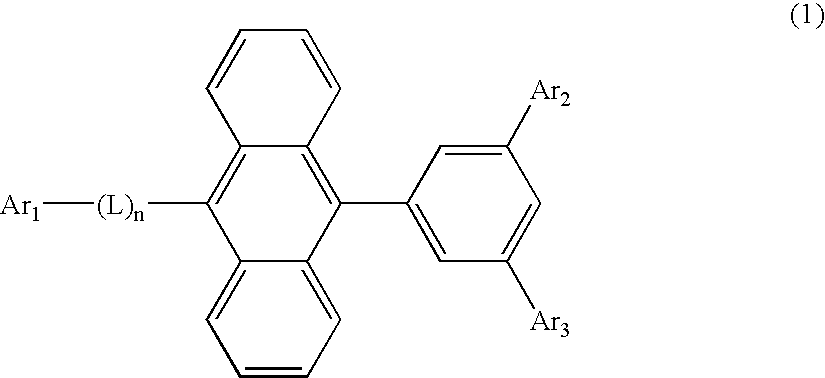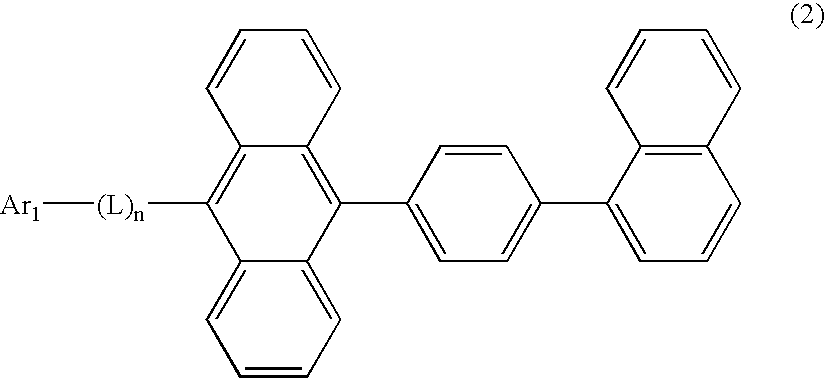Organic-electroluminescence-material-containing solution, method for forming thin film of organic electroluminescence material, thin film of organic electroluminescence material and organic electroluminescence device
a technology of organic electroluminescence and organic el, which is applied in the direction of pyrene dyes, methine/polymethine dyes, and anthracene dyes, etc., can solve the problems of complex manufacturing process, high vacuum and high cost, and the coating method is not applicable to low-molecular organic el materials. , the solubility is still insufficien
- Summary
- Abstract
- Description
- Claims
- Application Information
AI Technical Summary
Benefits of technology
Problems solved by technology
Method used
Image
Examples
example
[0125]Next, inks prepared as examples of the organic EL material-containing solution will be described.
examples 1 to 46
[0126]Preparation of inks (Ink 1 to Ink 46) was performed as follows.
[0127]Specifically, samples of a host compound and a dopant compound were blended in a weight ratio of 20:1 in a sample pot, to which a solvent and a viscosity control agent were added.
[0128]The result is shown in Table 5 and Table 6.
[0129]Table 5 and Table 6 each show a type of solvent, solid content (wt %), solubility (o: no insoluble matter visually observed, x: insoluble matter visually observed), viscosity and a solution condition after a week.
[0130]In Examples 1 to 46, preferable compounds of the present invention were used as the host and the dopant, the toluene (the aromatic solvent) was used as the solvent, and the alcohol type solutions were used as the viscosity control agent.
[0131]Examples 1 to 46 showed good solubility, viscosity and pot life.
[0132](Comparison 1)
[0133]An ink was prepared using only the toluene as the solvent.
[0134]The result is shown in Table 6 as Ink 47.
[0135]Although an insoluble mat...
example 47
[0218]As Example 47, the organic EL device was manufactured as described below.
[0219]A glass substrate (size: 25 mm×75 mm×1.1 mm thick) having an ITO transparent electrode (manufactured by GEOMATEC Co., Ltd.) is ultrasonic-cleaned in isopropyl alcohol for five minutes, and then UV / ozone-cleaned for 30 minutes.
[0220]Polyethylene-dioxy-thiophene / polystyrene sulphonic acid (PEDOT / PSS) to be used for the hole injection layer was deposited on the substrate by the spin coating to form a film having a thickness of 100 nm.
[0221]Then, a toluene solution (0.6 wt %) of Polymer 1 shown below (Mw: 145000) was deposited by the spin coating to form a film having a thickness 20 nm, which was dried at 170° C. for 30 minutes.
[0222]Next, the luminescent layer was formed by the spin coating using Ink 28 of the example described above. The thickness was 50 nm at this time.
[0223]Then, on the luminescent layer, a tris(8-quinolinol)aluminum film (hereinafter, abbreviated as Alq film) having a thickness of ...
PUM
| Property | Measurement | Unit |
|---|---|---|
| viscosity | aaaaa | aaaaa |
| viscosity | aaaaa | aaaaa |
| thickness | aaaaa | aaaaa |
Abstract
Description
Claims
Application Information
 Login to View More
Login to View More - R&D
- Intellectual Property
- Life Sciences
- Materials
- Tech Scout
- Unparalleled Data Quality
- Higher Quality Content
- 60% Fewer Hallucinations
Browse by: Latest US Patents, China's latest patents, Technical Efficacy Thesaurus, Application Domain, Technology Topic, Popular Technical Reports.
© 2025 PatSnap. All rights reserved.Legal|Privacy policy|Modern Slavery Act Transparency Statement|Sitemap|About US| Contact US: help@patsnap.com



